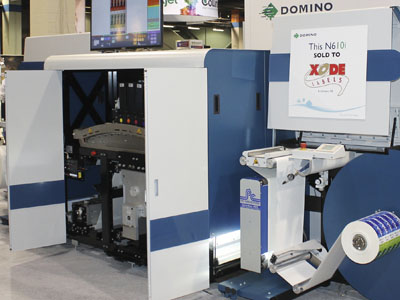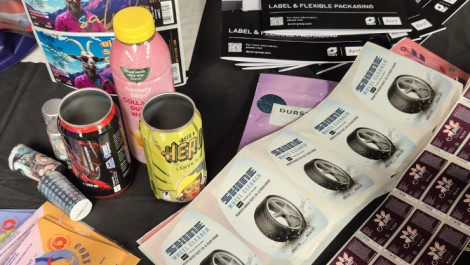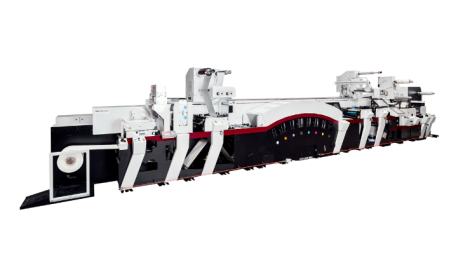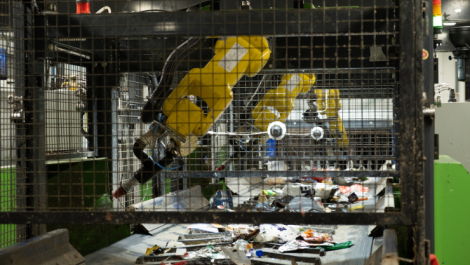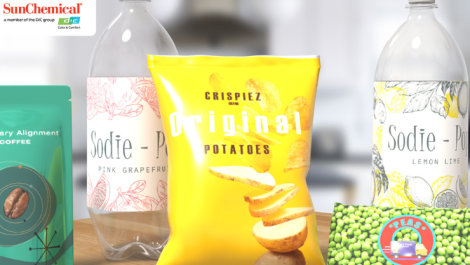Domino’s N610i inkjet press
Narrow web inkjet presses have gradually grabbed increasing share of the label market across the world, and there are numerous vendors competing in this very crowded marketplace. Sean Smyth gives an overview.
It is a global market. Beijing Founder, Miyakohsi, Shiki and Iwatsu have all shown their narrow web presses in Europe, but few have been sold. At Asian print and label shows, I come across companies I had never heard of before showing inkjet label machines. At the K-Print exhibition in Seoul last September, the folks at Dilli confidently told me they had sold ‘many tens’ of the NeoMercury label presses into the domestic market, although I am unsure if I have translated this figure accurately. What is a fact is it had five of them on its stand, which it confidently predicted would be sold at the show.
While not all suppliers are active in the Europe, it is difficult to see how they can all continue profitably, particularly considering HP and Xeikon with their toner presses. The shake out of suppliers has not occurred yet, and Labelexpo in Brussels in September will showcase several more inkjet press manufacturers entering the sector.
Highly productive
There are some 1000 high performance inkjet label presses in use across the world. Durst said it placed over 60 presses in the last year or so. The Tau 330 E is the entry level roll-to-roll configuration, while the Tau LFS 330 includes integrated laser finishing system onto a 330 mm print width at 48 m/min in seven colours including white. Durst uses the Xaar 1003 piezo head with UV curing inks, which is also used in EFI Jetrion presses, INX, Systec, Hapa, CSat, the SPGPrints DSI press and Edale/FFEI Graphium.
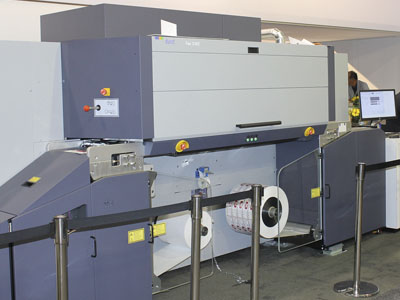
The entry-level Tau 330E from Durst
FFEI has a long history in inkjet, making the Caslon in partnership with Nilpeter and then taking that experience in the Graphium hybrid label press. The first one in the UK was placed into Wellingborough converter ProPrint in 2016.
The press was supplied by Edale, which has a fleet of its flexo presses there, and is printing labels and cartons. ‘The Graphium is a very strategic investment for us,’ said ProPrint founder and director James Denny. ‘The label market is dynamic, changing rapidly and our philosophy is to change with it to meet the evolving needs of customers. The combination of conventional and digital printing capabilities gives us the power and flexibility to produce a wide range of products with the ability to add variable data and a variety of special and tactile effects all on the one press.’
The Graphium is 420 mm wide, with two flexo stations; four-colour plus white inkjet; a Xaar Print Bar; with lamination, die-cutting and rewinding, printing at 50 m/min. The Xaar Print Bar System enables a range of inks and varnishes to be jetted at variable position in the line. This allows special effects including protective lacquers, high-build spot varnish and cold-foil adhesives.
‘The Graphium press is highly productive solution which is a perfect fit for ProPrint which is a highly innovative company,’ said James Boughton, managing director of Edale. ‘We have always looked at the relationship between ProPrint and Edale as a partnership and I look forward to working with, and supporting, them with the Graphium and their long term growth plans.’ Edale believes in the benefits of hybrid inkjet/flexo production and report a lot of interest from large packaging and label suppliers looking to harness the benefits of high performance taking advantage of the strengths of analogue and digital capability.
In combination
Philip Easton, director, Domino digital printing solutions, reported significant progress in combining flexo and inkjet in a single pass operation. He said, ‘Domino has supplied narrow web hybrid solutions in conjunction with AB Graphics, MPS, OMET and CEI with 13 systems now sold. We launched the N610i integration module designed for hybrid solutions at Labelexpo 2015 and it has opened up new market opportunities for us. The hybrid format is especially suited for applications where there are multiple SKUs per production job. One customer used to spend days on printing a job with 60 SKUs, but now with the N610i hybrid solution it is taking just hours. Having looked at a number of business cases with label printers, the broader print capability of a hybrid solution is an excellent way to remove a high proportion of smaller and medium sized production jobs away from flexo presses, significantly improving a label printer’s productivity.’
Several other suppliers are adding inkjet firepower to their flexo and existing digital presslines. Gallus, Mark Andy, Nilpeter, Omet, MPS and Edale all provide inkjet units alongside their flexo machines.
Nilpeter has integrated the Screen inkjet engine, utilising the high performance web handling to print and convert at up to 50 m/min on paper and filmic substrates from 90-350 microns. Options include flexo print units, lamination, die-cutting with Nilpeter’s QC-Die smart stripping unit, and hot/cold foiling. The digital front end eliminates many repetitive manual tasks and automates the planning and step and repeat routines. Information is fed back in real time to the dashboard, which displays production data, and it features advanced online diagnostics that help reduce service calls.
The company is targeting existing digital press users, many from its existing customer base. ‘There is no winning technology that covers all applications,’ said Jakob Landberg, sales and marketing director. ‘This reflects the complexity of the label and packaging market, which contributed to the fact that Nilpeter always has been spearheading combination printing. Now we can add reliable and highly productive digital printing and finishing applications, which meet global brand owners’ expectations, to the menu.’
Excitement
Screen is also selling its Truepress Jet L350UV into label converters, reporting a growing user base for this machine. One customer is Baker Labels, which put its first inkjet machine in early in 2016. The company is a leading trade printer and was an early adopter of digital technology, so it was interesting to learn they opted for an inkjet press alongside its HP Indigo and Nilpeter presses.
Steve Baker, managing director, commented, ‘Our Screen inkjet line is a brilliant press, combining quality and speed it just runs and runs with very good uptime and excellent stability. We have been through a learning curve on substrate suitability from light films to aluminium foils. I am excited by the opportunities to improve the service we provide to customers who are always looking for faster turnround and new features. We want to exploit the digital capabilities better and I am looking forward to seeing the next generation of machines at Labelexpo later this year. Inkjet is very tasty!’
These machines use UV curing inks, there are also several water-based machines. Epson has sold more than 200 of its high quality SurePress L-4033AW presses and has launched a higher performance single pass UV model.
As well as the high performance presses, there is a growing sector of low-cost, lower performance machines using water-based inks. These may be used by converters as an entry into digital or for samples and prototypes, and by commercial print companies entering the label market. The biggest sector is small to medium end users of labels who take production in-house, usually to improve their flexibility. Some use very cheap office/desktop printers but the range from £5-30,000 is becoming increasingly significant with suppliers including Epson, Afinia, ITE, Primera, VIP, TrojanLabel and QuickLabel aggressively attacking this market.
Inkjet technology is improving all the time, in reliability, quality, productivity and cost. It is inherently flexible and scalable; if you think one could improve your business there is a lot of choice.
Read the full issue here

